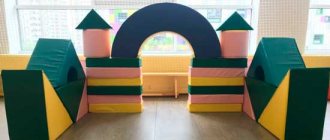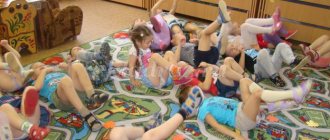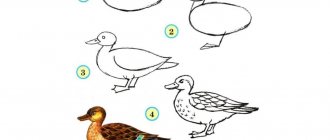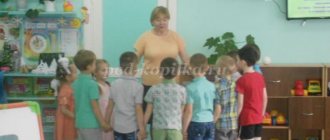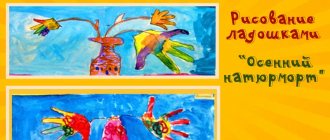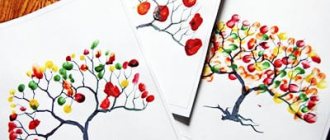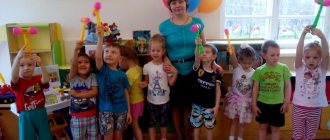Guide to drawing according to children's ideas
Detsky sad.Ru >> Electronic library >> Family and children >> Children's creativity >> E. A. Flerina. “Fine creativity of preschool children” Uchpedgiz. Moscow, 1956 OCR Detskiysad.Ru Given with some abbreviations
This type of drawing can be in the nature of group classes, and can also be done in free time.
In the process of observations and experimentation, we clarified the difference between these types of drawing according to the child’s plan. In those groups where the teacher was able to support children's interest in drawing, we observed an irresistible need for drawing in their free time. With maximum spontaneity, the child expresses on paper what worries him, his new impressions, returns to his favorite images - after all, in this way he can make them act according to his own desire. So, Kolya, six and a half years old, having heard stories at home about naval battles and the heroism of Soviet sailors, came to kindergarten and immediately sat down at the table and depicted a warship. He positioned the cannons on the ship so that they fired in all directions; the sheet of paper was covered in lines (“This is fire”). When he finished, he said triumphantly: “That’s how they fought! All the enemies were killed, all their ships were blown up.” Smiling, he stood up and went about other things. Many similar examples could be given that testify to the great importance of drawing during play hours. Such drawing, as it were, continues in graphic form a child’s active life, a child’s game of assimilation and processing of life impressions. This type of drawing requires special guidance. You can easily frighten away, deprive the creative mood of meaning and spontaneity. Freedom and courage in drawing of this type in older children (6-7 years old) is possible only if its quality improves and satisfies the child, if it is properly supervised. Unfortunately, this type of drawing is most often not taught in kindergarten; usually it is encouraged only as a convenient way for the teacher to fill children's time. The teacher sometimes does not even follow such a basic requirement as “not to disturb those who are drawing,” since he himself does not always treat children’s creativity with care. Sometimes you can see how children sloppily throw these drawings, crumple them, make “flying birds” out of them, etc. In this case, this type of drawing comes to naught and does a disservice to other types of drawing, since the sloppiness and disinterest observed at the same time, it has a detrimental effect on those visual skills that the teacher teaches children while drawing on assignment. In the group where the experiment was carried out, we encountered similar facts. After a meeting with the teacher and the head of the kindergarten’s pedagogical department, we carried out appropriate work to improve the management of this type of drawing and quickly saw how this helped improve the overall work of drawing. First of all, it was necessary to change the children's attitude towards this type of drawing. We told the children: “Children, yesterday we looked through your boxes of drawings. Open it and see for yourself." The guys opened it and looked: everyone’s drawings were in complete disarray, sloppy, crumpled, unfinished. The teacher drew attention to the fact that among them there are many good drawings that are nice for everyone to see, but most of the drawings are unfinished and poorly stored. The first viewing was unexpected and excited the children. The teacher noted that the work of many children who draw well is “unrecognizable”: “Is this Colin’s drawing? Is this a drawing of Valya?” They compared them with their drawings made in class according to the assignment. The difference was so obvious that the children were extremely confused. It was decided that everyone would look through their drawings, put them in a folder, and finish the unfinished ones. The children diligently began to put order in their drawers and made folders. The teacher took this endeavor very seriously, kept order, and encouraged the children who corrected and completed their drawings. With the same goal - to raise interest and create a serious attitude towards drawing in their free time - the teacher began to closely monitor the mood of the children who sat down to draw. And if he saw that the child was not serious and sat down to draw because he had nothing to do, he suggested: “Do something else, you don’t want to draw, but you sat down like that because you have nothing to do. When you really want to draw, then please sit down and draw.” Some children were puzzled and surprised by this unusual refusal; they did not always agree to another activity, claiming that they seriously wanted to draw. “Then draw,” the teacher allowed, “just so that no one bothers you and you don’t bother anyone.” Such exactingness forced me to concentrate my attention and take drawing seriously. Children's attitudes towards this type of drawing have changed dramatically. They sat down to draw calmly and in a businesslike manner; it was clear that many had the topic thought out in advance. From time to time, the children eagerly looked through their work, counted how many drawings they had, and sat for a long time “finishing” those that did not satisfy them. And when one day the teacher asked everyone to choose the two best drawings in their folder for the exhibition, Alik, whose drawings used to be particularly sloppy, said: “Choose for yourself, now all of them are good.” And indeed, his drawings became more meaningful, more colorful and neater. In the development of children's drawings, according to the plan, a serious role was played by the attitude, attention and respect for the child's invention, for his plans for creative work, which were established in the group. The teacher noticed with sincere pleasure every manifestation of genuine children's initiative. When analyzing the drawings, special attention was paid to this aspect. “This is how interesting Tolya came up with. Look what an interesting drawing Inna has. Sasha and Kolya were sitting next to each other, but they drew them completely differently. Everyone can think and draw for themselves,” said the teacher. If the drawing was imitative, the children spoke disapprovingly of it. Sometimes the teacher even had to defend someone who “didn’t come up with it himself,” saying that “he drew it in his own way.” Despite the obvious effectiveness of all these techniques, they could still have only a temporary effect on increasing children’s attention to the quality of the drawings created on their initiative. The improvement in quality was facilitated by the general management of all types of children's drawing and, in particular, by clearly identified and implemented elements of learning in the form of systematic tasks performed by children. The unity of management of various types of children's drawing makes each type full-fledged, positively influencing the other type of drawing. Pencil, paints, paper become the child’s companion, his assistant in assimilating the world around him. And we need to create all the conditions conducive to this. The most valuable thing here is the realization of children's experiences and ideas, finding images to express them, consolidating certain creative or technical achievements. This type of children's independent activity promotes the development of initiative, imagination, memory, feelings and will. In these classes, children's ideas are realized in concrete images. Drawing according to the child’s intention is a sensitive barometer in the development of a child’s drawing. If it is poor, inexpressive, if the child is lethargic, without interest and visible results, engages in this type of drawing, then we can safely say that in this case the entire management of children’s drawing is fundamentally wrong. And, conversely, courage, independence, a wealth of creative initiative and the full quality of children's drawing are, by design, an indicator of clear guidance. In guiding children's drawing, one should methodically correctly use: 1) the beginning of classes and instructions from the teacher, 2) a model, 3) demonstration, 4) imitation and example of the teacher, 5) children's mutual criticism and mutual assistance. continuation …
Preview:
Summary of GCD drawing in the middle group
“According to plan” Teacher of the Saransk preschool educational institution “Kindergarten No. 43 of a combined type” Vlasova Alina Evgenievna
Develop creativity and imagination.
Handouts: Colored pencils, album sheet for each child.
Didactic material: Drawings as an example, Masha doll.
Contents of educational activities
1) Educator: Hello Guys, look who came to us today?
-That's right, Masha doll. Let's say hello to her! (Say hello)
-Look how sad the doll Masha is. She told me that she doesn't know how to draw. Guys, can you draw? (Yes)
2) -Let's draw a picture for the doll so that she won't be sad. (Yes)
-What would you like to draw for Masha? (Flower, toy, car)
"Drawing by Design." Summary of GCD in the middle group
Svetlana Panchekhina
"Drawing by Design." Summary of GCD in the middle group
Topic: “By design ”
Program content: Teach children to independently choose the theme of their drawing, bring their plans to the end, hold a pencil correctly, and paint over small parts of the drawing. Develop creativity and imagination. Foster independence.
Materials: colored pencils, album sheets for each child.
Ioo: cognitive development; speech development.
1. Organizational moment. The teacher invites the children to remember what they drew before . (Children's answers.)
Then the teacher explains that today they will
each draw what they want, asking the children what they would like to draw .
2. Drawing technique . The teacher reminds you of the rules of drawing : the ability to hold a pencil correctly, draw large on the entire sheet , paint over the drawing with a pencil, drawing lines and strokes in one direction (from top to bottom or left to right, not to go beyond the contour.
3. Independent work of children, the teacher helps individually, if necessary. While drawing, the teacher encourages an interesting idea , stimulates the addition of drawings with images that have a similar meaning, and asks questions that encourage them to expand the idea . After finishing the work, the teacher invites the children to attach the finished drawings to the magnetic board, examine them, choose the most interesting ones, and ask those who drew them to tell about them. The teacher praises the children who conceived and implemented the most interesting images.
4. Finger gymnastics “Fingers went for a walk”
.
One two three four five,
The fingers went out for a walk (Children clench and unclench their fingers)
This finger found a mushroom,
(Children tap their thumb lightly)
5. Summary: What did you do today? What did you draw with ? What did you draw ?
Long-term planning for drawing (middle group) Topic: Large and small carrots. Goal: Learn to depict oval-shaped objects, placing them on the entire sheet and conveying the main color.
